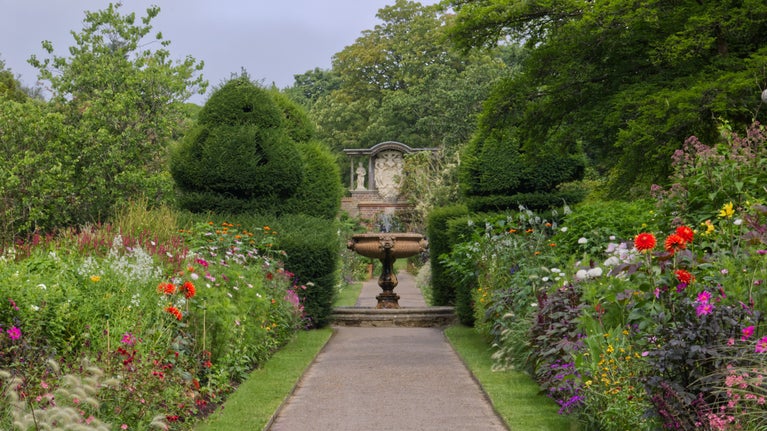
Gardens and landscapes
Find out more about the historical landscapes that the talented garden teams work hard to conserve at the places you love to visit.


A ha-ha is a type of sunken fence that was commonly used in landscaped gardens and parks in the 18th century. The point of the ha-ha was to give the viewer of the garden the illusion of an unbroken, continuous rolling lawn, whilst providing boundaries for grazing livestock. Discover the history of the ha-ha and find out where you can see excellent examples of the design at places in our care.
A ha-ha is created by digging a deep, dry ditch, the inner side of which would be built up to the level of the surrounding turf with either a dry-stone or brick wall. Meanwhile, the outer side was designed to slope steeply upwards, before levelling out again into turf.
Originally a feature of formal French gardens of the early 18th century, the ha-ha was first described in print in 1709 by the gardening enthusiast Dezallier d’Argenville in his La Theorie et la Practique du Jardinage (The Theory and Practice of Gardening).
According to d’Argenville – and his first English translator, John James – the ha-ha derived its name from the success of the optical illusion it created from a distance on viewers of the garden: the concealed ditch and wall would ‘surprise the eye coming near it, and make one cry,‘Ah! Ah!’’
The gardens at Stowe were among the first – if not the first – in England to possess a ha-ha. The ha-has installed by Charles Bridgeman and John Lee in the 1720s, under the patronage of the first Viscount Cobham, were certainly those that met with the greatest interest from visitors belonging to the landed classes with estates of their own in which to copy the design.

Writing to his cousin, Daniel Dering in 1724, John Perceval, 1st Earl of Egmont (father to the Prime Minister, Spencer Perceval), observed of Stowe: ‘What adds to the beauty of this garden is, that it is not bounded by walls, but by a ha-hah [sic], which leaves you the sight of the beautiful woody country, and makes you ignorant how far the high planted walks extend.’
Accordingly, following the examples at Stowe, the ha-ha was enthusiastically adopted throughout the parks and gardens of the country under the reigns of the first four King Georges. Its popularity was attributable to the Georgian taste for landscapes favoured by influential writers like Joseph Addison, who encouraged his readers to seek out prospects that were ‘naturally apt to fill the mind with calmness and tranquillity’ and thereby form ‘virtuous habits of mind.’
Since such perfectly harmonious views were rare natural occurrences, they had to be artificially created with the help of devices such as ha-has. Therefore, poet Alexander Pope offered his friend, Richard Boyle, the practical advice to ‘surprise, vary and conceal the bounds’ of his garden in order to create the desired effect.
By 1814, readers of Jane Austen’s Mansfield Park would have had little problem understanding Miss Crawford’s remark on ha-has, which touches on their efficacy in preserving the appearance of uninterrupted verdure: ‘I have looked across the ha-ha till I am weary. I must go and look through that iron gate at the same view, without being able to see it so well.’
Stowe is home to one of the very first ha-has in England, which gained widespread public notice and admiration in the 1720s and 30s. They were to prove the models for many of the ha-has still in existence across Britain today.
Berrington Hall was 'Capability' Brown's final commission. A long, sweeping ha-ha separates the pleasure ground from the parkland beyond.

Charles Bridgeman, who was behind the development of the ha-has at Stowe, went on to work for the first Duke of Newcastle at Claremont, where he reproduced the same style of ha-ha for his new patron.
The park at Croome was also designed by 'Capability' Brown, and includes over 2 miles of ha-ha.
The garden at Kedleston Hall was designed in the mid-18th century by the celebrated architect Robert Adam and includes a number of ha-has.
A brick ha-ha separates the formal garden from the parkland at Kingston Lacy, the lavish home of the Bankes family since the 17th century.
Petworth's rolling parkland gives every impression of being totally natural but, in reality, nothing is further from the truth. The park was dramatically transformed in the 1750s and early 1760s by Lancelot ‘Capability’ Brown and features a signature ha-ha.
Geraldine Porter is a specialist in 18th-century British politics at the University of Oxford.

Find out more about the historical landscapes that the talented garden teams work hard to conserve at the places you love to visit.
Find out more about our Trusted Source articles, which were created in partnership with the University of Oxford, and explore topics related to the special places in our care.

Dovecotes were built by wealthy and aristocratic families from the Norman period onwards and doves were kept for both food, feathers and as status symbols.

A hermitage is both a place where religious men lived to escape the temptations of the world and a retreat for 18th century aristocrats to take rest on their walks. See these architectural features across Britain.

The history of the English landscape garden is infused with political meaning. Learn the history and political stories behind this garden style characterised by structured informality.

Explore how changing tastes influenced the style of gardens over the centuries and discover where you can find the best examples from each period at the places we care for.

Open space campaigners sought to preserve countryside for recreation. Discover the history of the movement and how it inspired our work.

Find out more about the picturesque aesthetic style and how it became a fashionable choice for wealthy estates in the 18th century. Discover more about the people who influenced the movement.
